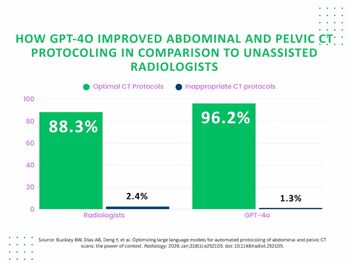
Ultrasound Surpasses CT in Imaging Kids for Appendicitis
CT use has declined precipitously with pediatric appendicitis patients without a significant change in negative appendectomy rates.
Radiologists are now turning more to ultrasound over CT when evaluating children for appendicitis.
Over the past 15 years, providers have increasingly followed guidance laid out in the Image Gently campaign, more often pivoting toward the radiation-free modality when assessing pediatric patients for this condition. Not only has this shift reduced the rate of negative appendectomies, but it has produced several other benefits, as well, said a team from both Texas Children’s Hospital and Cincinnati Children’s Hospital Medical Center.
Overall, the team determined CT use declined from roughly 57 percent in 2004 to 19 percent in 2018 while ultrasound utilization soared. The radiation-free modality rose from approximately 26 percent to 63 percent during that time span. The team of researchers published their analysis recently in the
“This change in utilization temporally coincides the advent of the Image Gently campaign and may be, in part, because of increased concern about the potential risks of ionizing radiation,” said the team led by Jonathan Dillman, M.D., associate chief of research in the Cincinnati Children’s radiology department. “Our study suggests that the shift away from CT to ultrasound has not adversely impacted a key outcome – the surgical negative appendectomy rate.”
In fact, the team pointed out, the shift toward ultrasound has also added value by improving patient outcomes and off-setting costs associated with unnecessary surgeries.
To best analyze this trend, the team evaluated imaging scans, including CT, ultrasound, MRI, and X-ray, from 104,033 patients ages 0 to 17 from 32 children’s hospitals between 2004 and 2018. According to their analysis, they found the negative appendectomy rate fell slightly from 3.74 percent to 3.14 percent. In addition to the changes in CT and ultrasound utilization, they also determined X-ray remained fairly flat, only declining slightly from 16.7 percent to 15.8 percent, and MRI rose minimally, increasing from 0.1 percent to 2.2 percent.
The continued minimal use of MRI was surprising, however, they noted, given this trend toward reducing radiation exposure.
“If the diagnostic imaging strategy for pediatric acute appendicitis is being driven, or substantially influenced by, a desire to reduce ionizing radiation exposure, MRI should have been more widely adopted,” they wrote.
It is possible, the team concluded, that lack of resources, radiologist comfort with MRI interpretation, and low overall comfort with the exam could play into the scant use of MRI with these patients.
There could also be another reason behind the drop in CT use, they said. The Centers for Medicare and Medicaid Services mandated code bundling for discrete codes of CT of the abdomen and CT of the pelvis into a single code in 2011, making the number of CT scans for appendicitis appear larger from 2004 to 2010. Still, they reiterated, the decrease in per-patient utilization they identified suggests a true diagnostic paradigm shift.
Newsletter
Stay at the forefront of radiology with the Diagnostic Imaging newsletter, delivering the latest news, clinical insights, and imaging advancements for today’s radiologists.




























